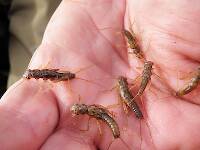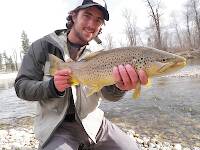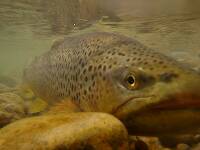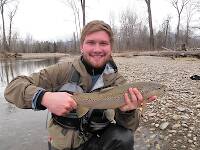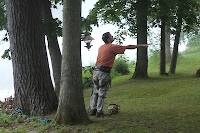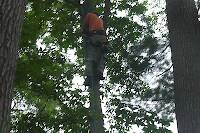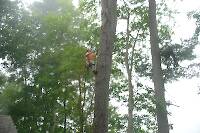
Hex Mayflies
Hexagenia limbata
The famous nocturnal Hex hatch of the Midwest (and a few other lucky locations) stirs to the surface mythically large brown trout that only touch streamers for the rest of the year.
Featured on the forum

I caught this tiny larva without a case, but it seems to key pretty clearly to to Glossosomatidae. From there, the lack of sclerites on the mesonotum points to either Glossosoma or Anagapetus. Although it's difficult to see in a 2D image from the microscope, it's pretty clear in the live 3D view that the pronotum is only excised about 1/3 of its length to accommodate the forecoxa, not 2/3, which points to Glossosoma at Couplet 5 of the Key to Genera of Glossosomatidae Larvae.

Troutnut is a project started in 2003 by salmonid ecologist Jason "Troutnut" Neuswanger to help anglers and
fly tyers unabashedly embrace the entomological side of the sport. Learn more about Troutnut or
support the project for an enhanced experience here.
Lastchance on Apr 14, 2009April 14th, 2009, 9:01 am EDT
I was fishing yesterday and there were BWOs hatching. I tried a dun, parachute, comparadun, emerger, nymph and floating nymph, but I only got lookers. I looked on the water and picked up what i thought was BWO emerger. Upon looking at the pictures of the Sedge taken in 2007 in the East, I'm beginning to wonder if there were also sedges of some kind emerging. It had a green body and was stuck in the shuck. It was small, maybe a size 18 or 20. Is that possible? Maybe those fish were eating them because they sure weren't interested in any of my BWOs. Any thoughts?
CharlieSawd on Apr 14, 2009April 14th, 2009, 2:31 pm EDT
Lastchance,
What you are describing sounds like a pharate adult, or emerging caddis. Did you see any caddis coming off the water? If you did not, several genera of caddis swim to the bank first and hatch there. I would imagine they were keying in on these caddis as they can be especially vulnerable making them easy to consume in large quantities.
-Charlie
What you are describing sounds like a pharate adult, or emerging caddis. Did you see any caddis coming off the water? If you did not, several genera of caddis swim to the bank first and hatch there. I would imagine they were keying in on these caddis as they can be especially vulnerable making them easy to consume in large quantities.
-Charlie
Charlie Sawdey
www.driftlessflybox.com
www.driftlessflybox.com
Softhackle on Apr 14, 2009April 14th, 2009, 5:13 pm EDT
Without a photo or a more detailed description, it's hard to tell what these were. Especially since they were stuck in their shuck. However, next time you run across this situation try a wingless wet. I know you said you tried an emerger, but the wingless wet can imitate just about any stage and various insects and is more likely to be accepted by the fish.
Mark
Mark
"I have the highest respect for the skilled wet-fly fisherman, as he has mastered an art of very great difficulty." Edward R. Hewitt
Flymphs, Soft-hackles and Spiders: http://www.troutnut.com/libstudio/FS&S/index.html
Flymphs, Soft-hackles and Spiders: http://www.troutnut.com/libstudio/FS&S/index.html
GONZO on Apr 15, 2009April 15th, 2009, 5:08 am EDT
...I'm beginning to wonder if there were also sedges of some kind emerging. It had a green body and was stuck in the shuck. It was small, maybe a size 18 or 20. Is that possible?
Yes, but as Mark suggests, anything else is speculation. Cheumatopsyche (little sister sedges) and Micrasema (little grannoms) are two caddisflies that are about the size and body color you describe. Both genera have species that emerge in the early season, but the timing seems a bit too early for either of these. (I can't recall encountering them much before the end of the month in most of the PA streams that I fish, but the temperature regime of your stream might be significantly different.)
Any thoughts?
Well, if the fly was an issue, I'd second Mark's suggestion--even without knowing whether the fish were feeding on BWOs or caddisflies. That style of fly often works well for either possibility.
However, if the water you fished was on the slow side, it's quite possible that it was less of an imitation problem than a slow-water presentation problem. Fish in slow water have a long time to inspect our flies, but they can also be put off by almost imperceptible drag or by the line/leader passing overhead. I'd be especially inclined to think that was an issue if you delivered your casts upstream or at an upstream angle over the fish. Although it runs contrary to standard practice, I find that a careful downstream presentation is often better at fooling fussy risers in slow water.
Another consideration that could compound any of the other issues is recent fishing pressure. Unless you were fishing in a place that gets very little pressure at this time of year, the fish might have been displaying added caution driven by recent exposure to the fly.
Softhackle on Apr 15, 2009April 15th, 2009, 11:53 am EDT
You can't have a better answer than the one Gonzo gave.I think his assessment is excellent. Mine was rather quick, and I have a tendency to answer questions like this in this fashion because it is hard to know exactly what the problem could be.
A couple weeks ago I was out on the local water and there were Black Stone flies hatching, but despite their numbers the fish were not taking them. They WERE, however, taking a rather small black midge, riding on the surface. Once we figured out what the fish were onto. we caught them consistently. Needless to say the trout I took were taken on a #18 Leisenring Black Gnat fished in the film, however fishing them as a wet on the swing didn't work very well. The combination of fly selection and presentation was the key. You needed to fish the fly in the film on a floating line.
So, as Gonzo has indicated, it could have been more than just the fly selection. There's just so many variables.
Mark
A couple weeks ago I was out on the local water and there were Black Stone flies hatching, but despite their numbers the fish were not taking them. They WERE, however, taking a rather small black midge, riding on the surface. Once we figured out what the fish were onto. we caught them consistently. Needless to say the trout I took were taken on a #18 Leisenring Black Gnat fished in the film, however fishing them as a wet on the swing didn't work very well. The combination of fly selection and presentation was the key. You needed to fish the fly in the film on a floating line.
So, as Gonzo has indicated, it could have been more than just the fly selection. There's just so many variables.
Mark
"I have the highest respect for the skilled wet-fly fisherman, as he has mastered an art of very great difficulty." Edward R. Hewitt
Flymphs, Soft-hackles and Spiders: http://www.troutnut.com/libstudio/FS&S/index.html
Flymphs, Soft-hackles and Spiders: http://www.troutnut.com/libstudio/FS&S/index.html
Lastchance on Apr 16, 2009April 16th, 2009, 12:45 pm EDT
Thanks, Guys: I realize the variables are many. Remembering the emerger I picked up I'm even more sure it was a caddis fly of some kind. Don't mayfly emergers have wing buds on top of their thoraxes? This bug had tiny wings sprouts on the side like caddis and the body was an olive color, which is probably why I assumed it was a BWO. Plus, they were in the air at the time. More variables--I saw them in a slow, long pool easily accessible and the first one on the stream. It always has rising fish in it and people are always throwing flies at them. If I had a camera I could have taken a picture of the emerger and eliminated all this discussion.
Thanks,
Bruce
Every time I get to the point I think I've learned a little about this stuff I realize how much I don't know. LOL!
Thanks,
Bruce
Every time I get to the point I think I've learned a little about this stuff I realize how much I don't know. LOL!
Quick Reply
Related Discussions
Topic
Replies
Last Reply
2
Mar 28, 2016
by Kschaefer3
by Kschaefer3
2
Nov 4, 2012
by Aszat
by Aszat



